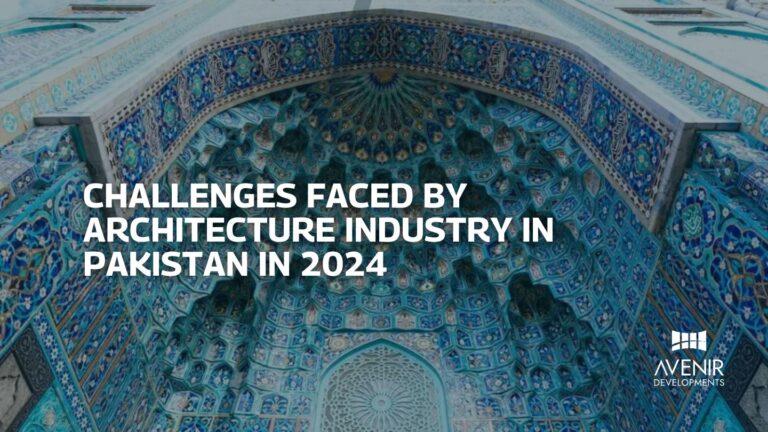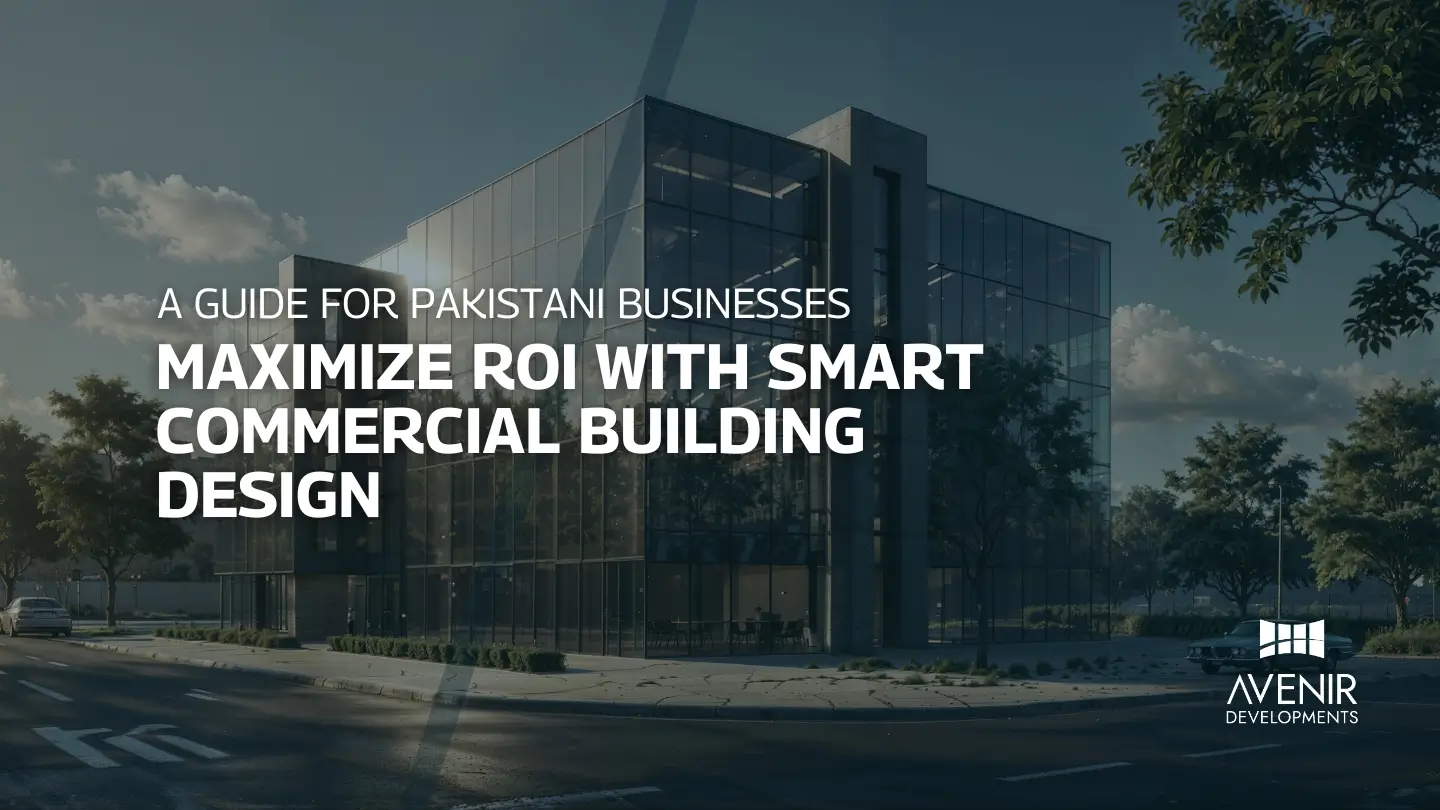Challenges faced by Architecture Industry in Pakistan are unique. Pakistan’s architecture industry, a cornerstone of our evolving urban landscape from Lahore’s historic heart to Islamabad’s modern avenues, is a sector brimming with potential. Yet, the journey from initial concept to completed structure is often fraught with a unique set of challenges. At Avenir Developments, our experience crafting distinctive spaces – be it elegant residences in DHA or dynamic commercial projects – has given us a firsthand understanding of these complexities.
This blog post will concisely explore the most significant hurdles facing architects and the wider construction industry in Pakistan today. Our goal is to provide clarity for homeowners, developers, and fellow professionals, fostering a greater appreciation for the intricacies involved in shaping our built environment within cities like Lahore and Islamabad. By understanding these key challenges, we can collectively work towards a more streamlined and innovative future for architecture in Pakistan.
Navigating the Regulatory Landscape: Codes, Compliance, and Governance
A clear and efficient regulatory framework is vital for any thriving industry. However, in Pakistan, particularly in dynamic cities like Lahore and Islamabad, architects often face a complex regulatory landscape. Inconsistent building codes, fragmented regulations, bureaucratic delays, and the issue of multiple licensing can significantly impact project timelines and costs.
Inconsistent Codes and Fragmented Regulations
The lack of standardized building codes across regions creates confusion and delays. While the Building Code of Pakistan 2021 (BCP-2021) aimed to establish a baseline, its uniform adoption faces hurdles. The diverse administrative landscape, with federal, provincial, and municipal regulations, leads to a patchwork of rules. This can compromise building safety and increase project costs.
Bureaucratic Delays and Approval Bottlenecks
Complex bureaucratic procedures and lengthy approval processes hamper the construction sector in Lahore and Islamabad. Obtaining permits can be time-consuming, adding a “time tax” to development costs. Under-resourced regulatory bodies can also contribute to these delays.
Multiple Licensing Challenges
Architects often face the burden of obtaining multiple licenses to practice across different jurisdictions, even with national registration. This restricts professional mobility and adds unnecessary financial strain. While some progress has been made, the issue persists.
Enforcement Gaps and Compliance Issues
Weak enforcement of regulations remains a concern. Issues like unqualified practitioners and the illegal use of professional stamps highlight these weaknesses. Stronger enforcement is needed to ensure building quality and public safety.
Economic Realities: Funding, Viability, and Market Dynamics
Beyond regulation, the economic climate significantly influences Pakistan’s architecture industry. Macroeconomic instability, inflation, funding constraints, and competitive pressures create a demanding environment for practices in Lahore, Islamabad, and beyond.
Macroeconomic Instability and Inflation
The industry is vulnerable to economic fluctuations, leading to project delays or cancellations. Inflation impacts construction costs and project feasibility, creating uncertainty for long-term planning.
Project Funding and Investment
Access to project funding and a favorable investment climate are crucial. However, constraints in public funding and a potentially uneven distribution of investment can limit opportunities for some architectural firms.
Fee Structures and Competition
Establishing fair fee structures is essential, but unethical fee undercutting can compromise design quality. The lack of robust, enforced fee guidelines can exacerbate this issue.
Taxation Burdens
Historically, taxation has posed challenges, although advocacy efforts have led to some reductions. However, it remains an operational cost impacting the profitability of architectural practices.
Bridging the Education-Practice Divide: Skills for Tomorrow’s Architecture
A critical challenge lies in the gap between architectural education and the practical demands of the profession in Pakistan. This disconnect impacts the readiness of graduates entering the dynamic markets of Lahore and Islamabad.
Curriculum Deficiencies
Many architecture graduates face a mismatch between their education and the skills required in practice. Curricula often lack sufficient focus on digital tools like BIM, offer limited practical exposure, and may not align with current industry needs.
Shortage of Skilled Professionals
The industry faces a shortage of skilled architects and specialized construction labor. This scarcity can lead to subpar designs, project delays, and compromised quality in the final built environment.
Quality of Education and Accreditation
Concerns exist regarding the quality of architectural education and the proliferation of non-accredited institutions. Ensuring consistent educational standards is a significant challenge for regulatory bodies.
Integrating Technology (BIM)
The adoption of modern technologies like Building Information Modeling (BIM) is slow in both education and practice, hindering efficiency and collaboration within the industry.
Need for Enhanced R&D
Limited funding for architectural education and research restricts innovation and the development of contextually relevant solutions for Pakistan’s unique challenges.
Upholding Professionalism: Ethics, Practice, and Intellectual Property
Maintaining the integrity and progress of the architectural profession in Pakistan hinges on strong ethical standards, clear practice guidelines, and the protection of creative work within Lahore, Islamabad, and across the nation.
Ethical Dilemmas and Enforcement
While professional bodies like IAP and PCATP have codes of conduct, ethical dilemmas persist, often driven by commercial pressures. Consistent enforcement of these standards is crucial for maintaining public trust.
Protecting Intellectual Property
Legal frameworks exist to protect architectural designs, but awareness and effective enforcement remain challenges. Plagiarism can discourage innovation and devalue original work.
Navigating Design Competitions
Design competitions can foster innovation, but issues like fairness and adherence to regulations need strengthening to ensure they are beneficial for architects.
Managing Client Expectations
Effectively managing client expectations, which are shaped by evolving design trends, is vital for successful projects and client satisfaction. Clear communication is key.
Addressing Construction Disputes
Construction disputes are common and can lead to delays and increased costs. Clear contracts and effective dispute resolution mechanisms are essential.
Building a Greener Future: Sustainability and Environmental Responsibility
The architecture industry in Pakistan faces growing environmental challenges, demanding a stronger focus on sustainable design and climate-resilient construction in cities like Lahore and Islamabad.
Integrating Sustainable Design
The adoption of sustainable practices remains underdeveloped, often overshadowed by aesthetic priorities. However, there’s a rising trend towards energy-efficient solutions, though widespread implementation faces barriers like perceived high costs and lack of awareness.
Overcoming Barriers to Green Certification
Adoption of green building certifications like LEED is low in Pakistan, highlighting challenges related to cost, awareness, and supportive regulations. Utilizing locally sourced, eco-friendly materials is crucial.
Climate Change Adaptation
Pakistan’s vulnerability to climate change necessitates designing for resilience. This includes adapting to extreme weather events and incorporating measures for energy efficiency in buildings and urban planning.
Resource Depletion and Local Materials
Responsible resource use and promoting local, sustainable materials are vital. Research into and adoption of indigenous materials can reduce environmental impact and support local economies.
Here’s the next concise section, focusing on identity, heritage, and public perception:
Identity, Heritage, and Public Perception: Shaping Cultural Landscapes
The architecture of Pakistan reflects its rich culture and history. However, the industry grapples with defining a contemporary national identity, preserving heritage amidst development in cities like Lahore and Islamabad, and fostering public appreciation for architectural value.
The Quest for a Contemporary Identity
Establishing a unique contemporary Pakistani architectural style is challenging due to the blend of traditional influences and global trends. This can sometimes lead to a diluted aesthetic or uncritical imitation of foreign styles.
Balancing Heritage and Development
Rapid urbanization often threatens historical sites. Stricter guidelines and investment are needed to preserve Pakistan’s diverse architectural heritage while accommodating modern development.
Decline of Traditional Craftsmanship
The neglect of traditional craftsmanship and a lack of contextual awareness in modern design result in buildings often lacking cultural depth and climate responsiveness.
Elevating Public Awareness
There’s a need to raise public awareness about the importance of good architecture and design, moving beyond the perception of architects as mere builders. This can foster support for quality design and heritage preservation.
Urban Futures: Architecture’s Role in Pakistan’s Evolving Cities
With rapid urbanization in Pakistan, particularly in Lahore and Islamabad, architects have a crucial role to play in addressing infrastructure deficits and shaping sustainable, inclusive urban environments.
Challenges of Rapid Urbanization
Rapid urban growth leads to overcrowding, traffic congestion, and environmental degradation. Inadequate infrastructure further complicates development and construction timelines in major cities.
Architectural Responses to Urban Issues
Architects are exploring strategies to address urban challenges like the Urban Heat Island effect through increased green spaces, reflective materials, and energy-efficient designs.
Shaping Sustainable and Inclusive Environments
Architects can contribute significantly to creating better urban outcomes by advocating for their inclusion in urban planning processes and focusing on affordable housing and universal accessibility.
Charting the Course: Strengthening the Profession for a Brighter Future
Overcoming the challenges facing Pakistan’s architecture industry requires a concerted effort to strengthen professional bodies, empower young talent, and foster a culture of innovation in Lahore, Islamabad, and across the nation.
Assessing Professional Organizations
PCATP and IAP play vital roles but face operational and strategic challenges. Enhancing their effectiveness is crucial for addressing issues from regulation to education.
Key Initiatives and Challenges
Both organizations are undertaking initiatives in areas like technology adoption and professional development but face hurdles in implementation and sustainability.
Empowering Young Architects
Nurturing young talent and fostering innovation are essential for the industry’s future. Addressing the high number of graduates and ensuring quality training and employment are critical.
Strategic Recommendations
A collaborative approach involving government, professional bodies, educational institutions, and practicing architects is needed. Key recommendations include regulatory reform, investment in education and R&D, promoting sustainability, strengthening professional organizations, modernizing curricula, and fostering collaboration.
Conclusion: Building a Resilient and Innovative Architectural Future
Pakistan’s architecture industry stands at a pivotal point. While facing significant challenges, the potential for growth and innovation is immense. By acknowledging these hurdles and working collaboratively towards strategic solutions, we can pave the way for a more resilient, sustainable, and culturally rich built environment for generations to come in Lahore, Islamabad, and throughout Pakistan. At Avenir Developments, we remain committed to contributing to this positive transformation, one thoughtfully designed and expertly built space at a time.







